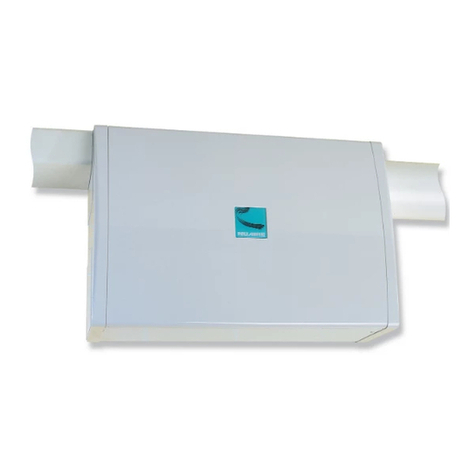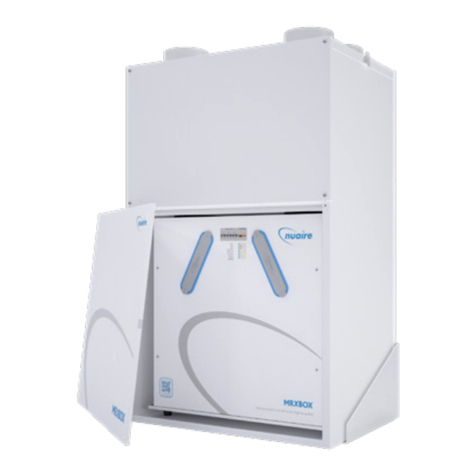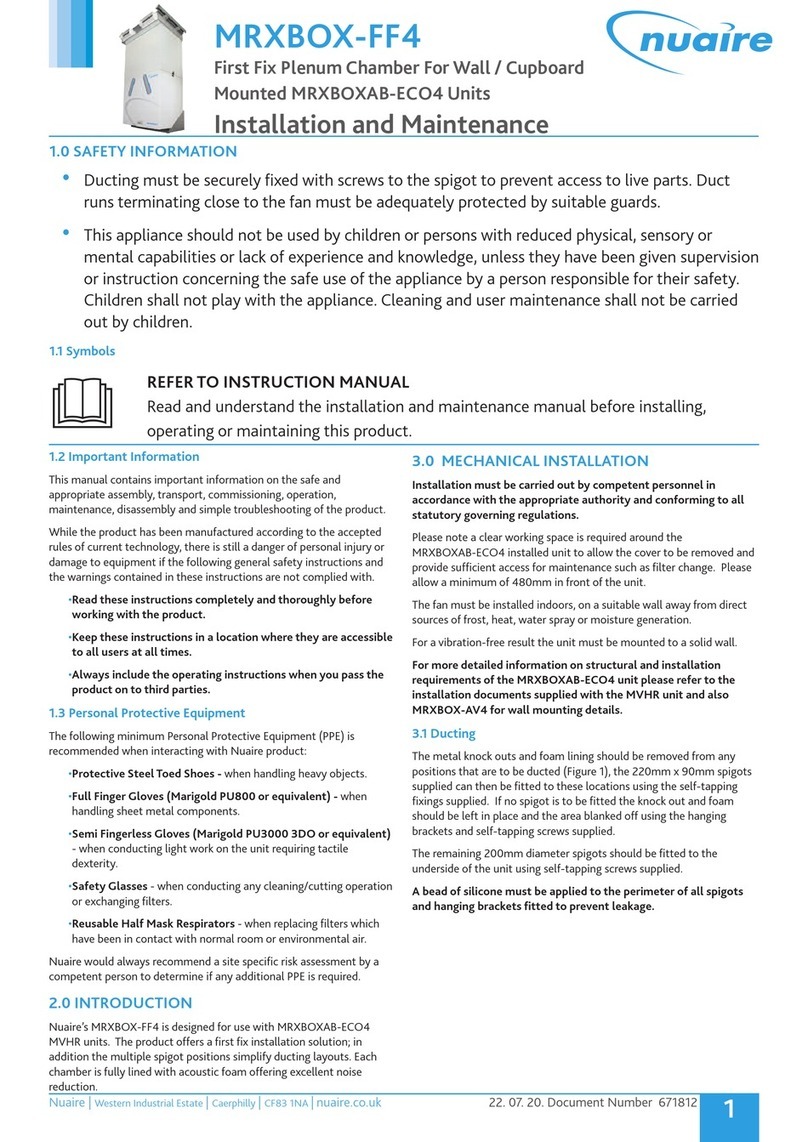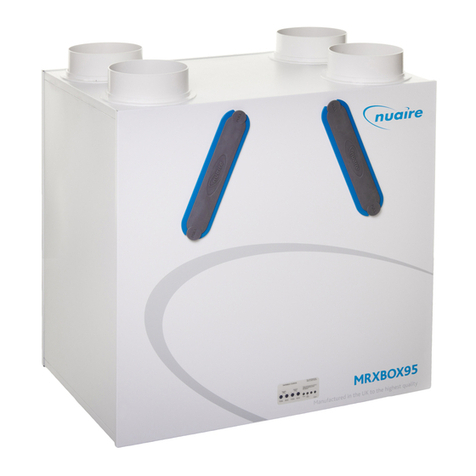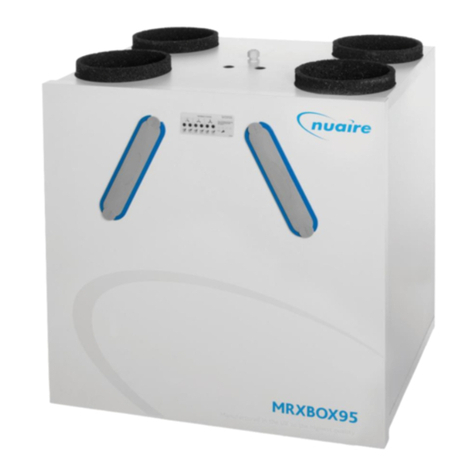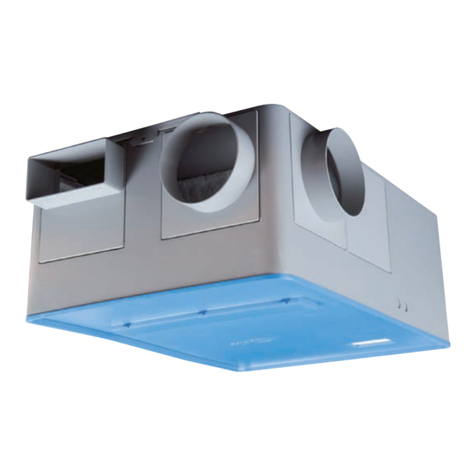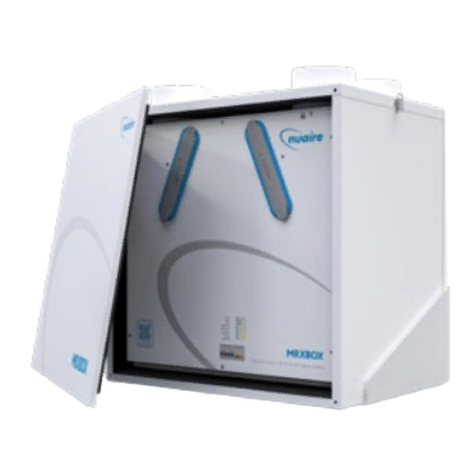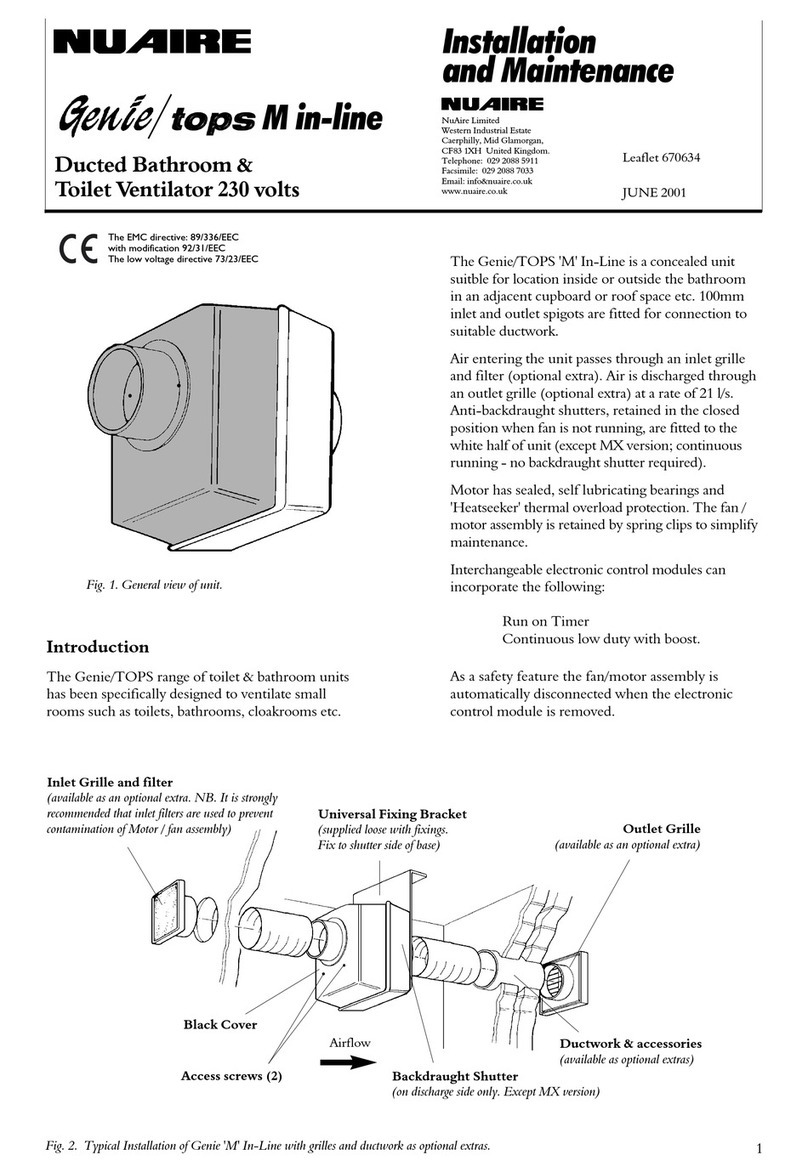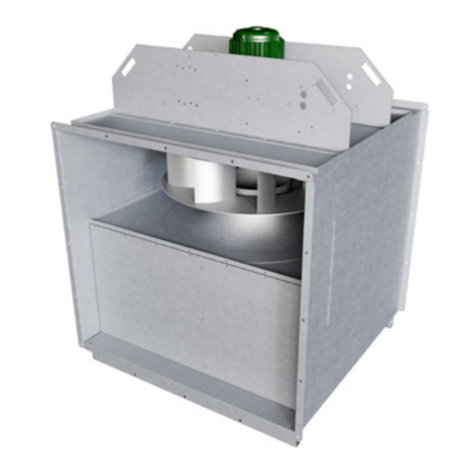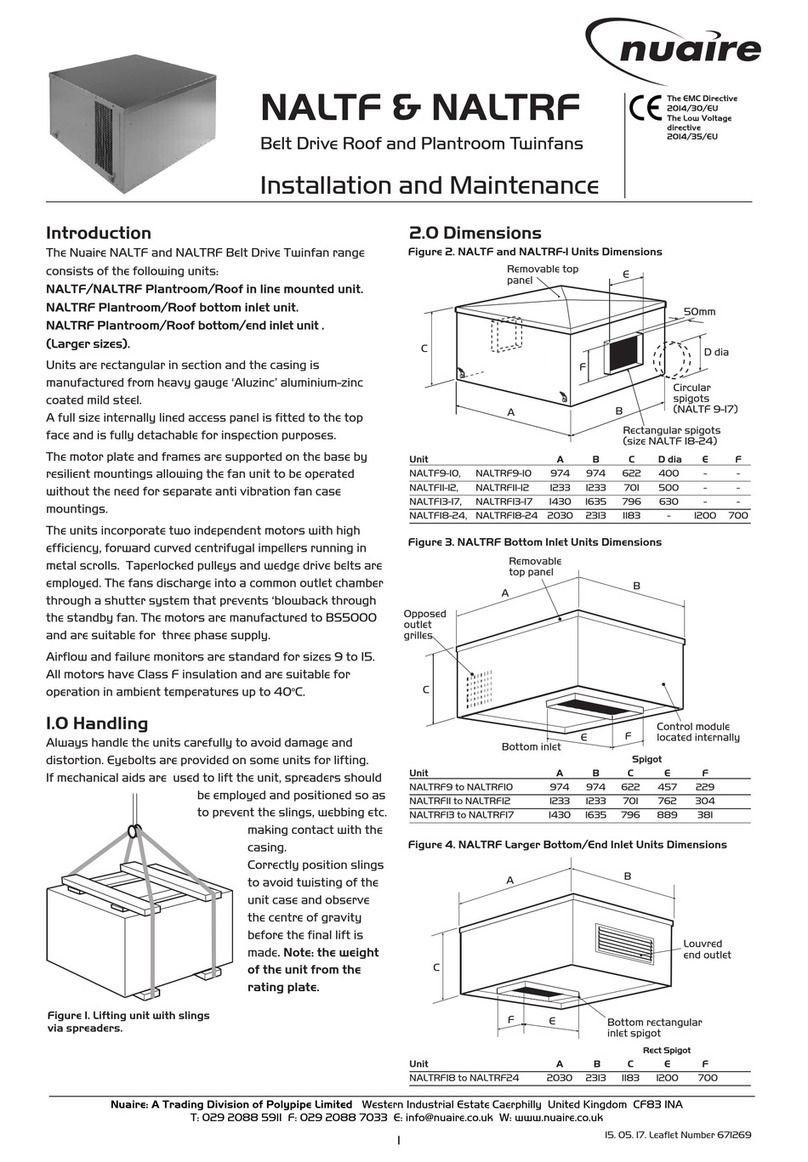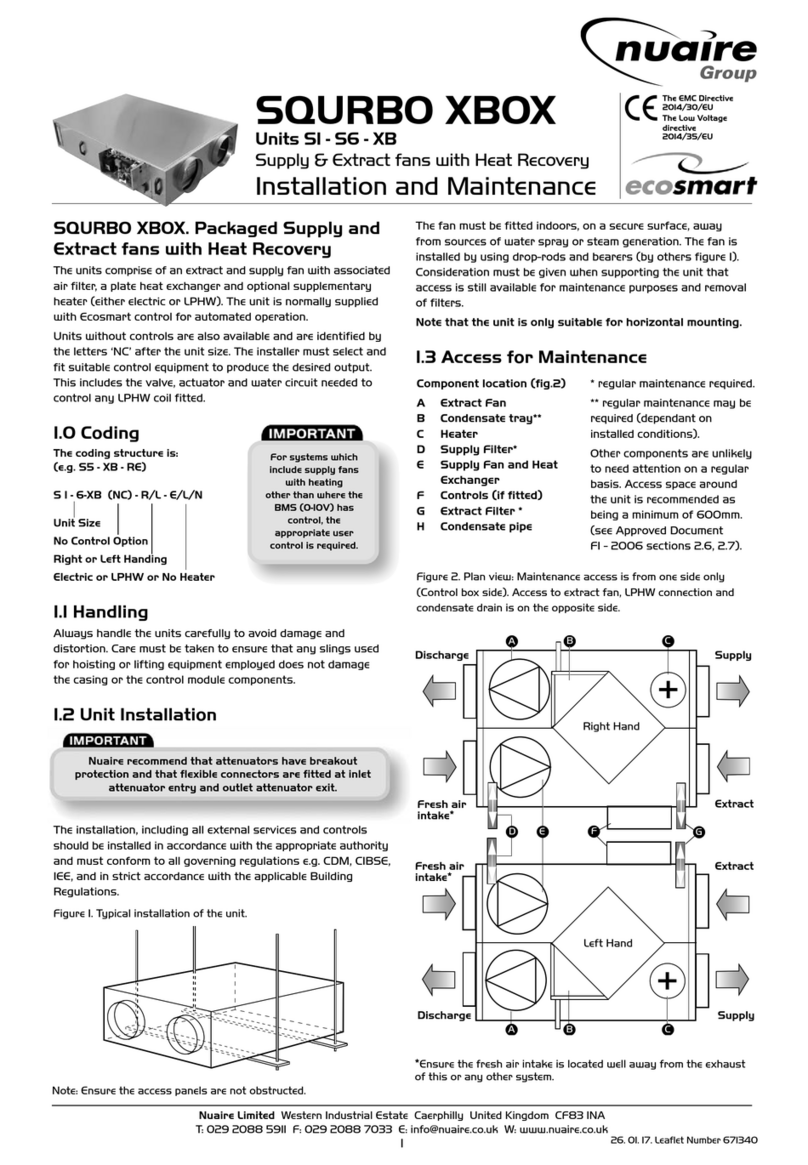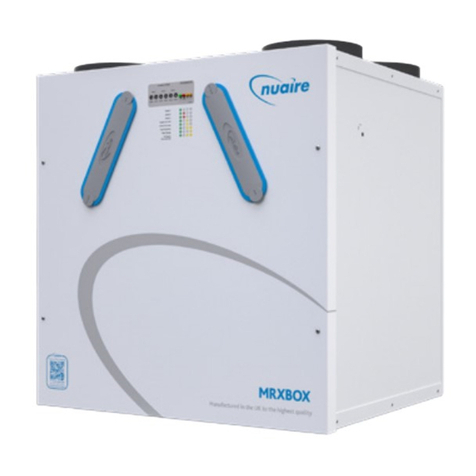
04. 02. 20. Document Number 671847 5
Nuaire | Western Industrial Estate | Caerphilly | CF83 1NA |nuaire.co.uk
AX
Installation Manual
IMPORTANT
Isolation - Before commencing work, make sure
that the unit, switched live and Nuaire controls are
electrically isolated from the mains supply.
6.0 SPECIFIC COMMISSIONING AND SERVICING
REQUIREMENTS
300°C for 2 hours / 400°C for 2 hours Motors for Smoke
Extract Fans
Motors for Smoke Extract Fans
These motors are used to provide a SAFETY FUNCTION for people
in the event of fire in public premises or in the home: they are
therefore subject to strict constraints concerning their operating and
maintenance.
Operating Constraints
i. Check on the nameplate that the selected motor corresponds to the
maximum exposure temperature and duration.
ii. Non ventilated motors MUST be placed in the airflow from the driven
fan. Ventilated motors can be placed outside the flow.
iii. AFTER THE MOTOR HAS BEEN SUBJECTED TO ONE EMERGENCY
DUTY OPERATION, IT MUST BE REPLACED.
iv. With variable speed control. Ensure that the maximum speed never
exceeds the speed of the motor supplied by the mains and that the
delivered power corresponds to the previous definitions. The motor
should be equipped with PTC thermistors connected to the protection
system during S1 duty and switched off during S2 duty (operation
during an emergency).
These qualifications ensure the qualification of the driven fan by the
manufacturer.
Maintenance Constraints
Regular service visits must be performed on the installation AT
LEAST EVERY 6 MONTHS, incorporating the following checks:
i. Checking the insulation resistance (R>100 MOhms, 500V DC)
•If the drain holes are blocked, open them to eliminate any
accumulated condensation.
•If R<100 MOhms, dry the stator in an oven and check the
insulation resistance. If the fault persists, replace the stator.
•The stator must be replaced 5 years after installation or after
20,000 hours of operation.
ii. Cooling check
•Ensure there is no dust or grease in the entire ventilation circuit
(housing fins, motor cover/fan if fitted driven fan).
•Ensure the motor runs normally when switched on for a few
minutes.
iii. Bearing check (C3 or C4 play)
Run the motor during each maintenance visit. When the motor is cold,
a high level of noise is caused by the texture of the grease. This does not
indicate a bearing fault.
S2 duty only:
The bearings must be replaced by an identical type every 5 years.
Ensure the motor runs normally when switched on for a few minutes.
S1 duty and Emergency in S2 duty:
a) Permanently greased bearings.
300°C / 400°C range; replace on 2 pole motors after 10,000 hours of
operation and on motors with 4 poles or more after 20,000 hours.
b) Re-greaseable bearings
The information on the motor nameplates must be strictly respected
(grease quantity, grease quality and re-greasing frequency).
The bearings must be replaced after 20,000 hours of operation.
7.0 MAINTENANCE
Only appropriately qualified personnel, familiar not only with the
electrical aspect of the work but with the plant, area or application
served by the unit, should carry out routine and preventative
maintenance on this product.
Ensure all mechanical and electrical connections and fixings are secure
and that inlet and outlet duct work is free of any obstruction or debris.
Briefly switch the fan on/off to ascertain correct direction of rotation,
compare the rotational label applied to the fan case and correct if
necessary.
It is important that maintenance checks are recorded and that the
schedule is always adhered to, in all cases, the previous report should
be referred to.
Maintenance should be carried out on a regular basis, Nuaire
recommend three months from commissioning and at least annually
thereafter as determined by the operating conditions and levels of
airborne contamination to which the unit is exposed.
7.1 Routine Maintenance
•Clean all areas of unit and treat any areas of corrosion.
•Check that bird guards/safety grilles are secure and free of
obstruction.
•Check motor for undue wear, signs of overheating and apply
winding insulation and continuity tests.
•Remove all dust and dirt from impellers, be especially careful not
to disturb balance weights.
•Check resilient mounts and replace any that show signs of wear or
deterioration.
7.2 Annually
•Thoroughly inspect the unit and its components for corrosion,
acting immediately to treat/restore any damaged areas.
•All electrical terminals within the unit should be tightened.
•Check all earth connections.
7.3 Bearing Lubrication
Motors are fitted with sealed for life bearings and do not require any
lubrication.
7.4 Impellers
Impellers are dynamically balanced during manufacture, no special
treatment is required during maintenance, other to clean and remove
all dust and dirt residue taking care not to disturb the balance weights.
Remove stubborn dirt with warm soapy water – do not use caustic
fluids.
The maintenance programme must conform to ‘good custom and
practice’ and to the published recommendations of associations such
as the HVCA, CIBSE etc. The HVCA’s publication ‘Standard Maintenance
Specification for Mechanical Services in Buildings’ Vol 2 Ventilating and
Air Conditioning is a recommended reference.
